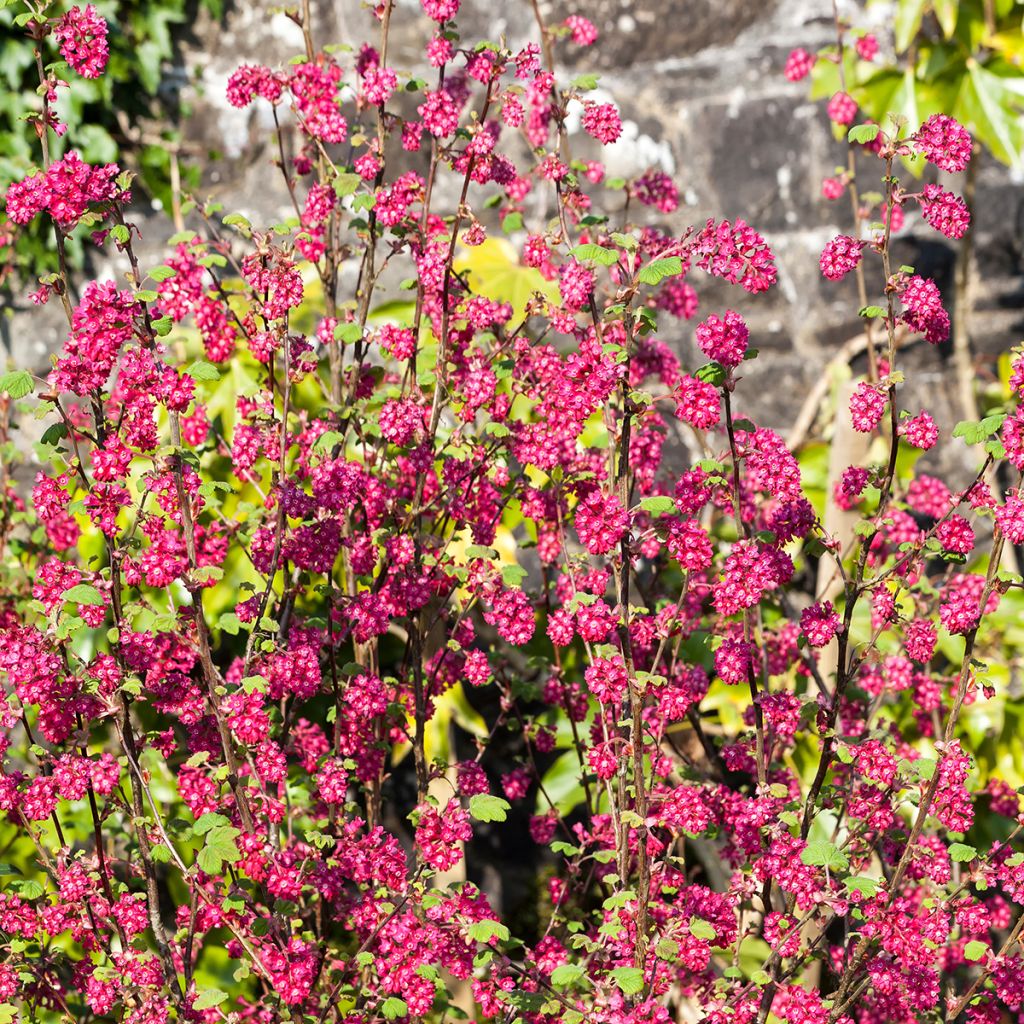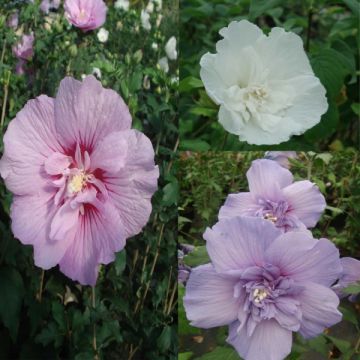

Ribes sanguineum Koja


Ribes sanguineum Koja


Ribes sanguineum Koja
Ribes sanguineum Koja
Ribes sanguineum Koja
Flowering Currant, Red-flowering Currant
Special offer!
Receive a €20 voucher for any order over €90 (excluding delivery costs, credit notes, and plastic-free options)!
1- Add your favorite plants to your cart.
2- Once you have reached €90, confirm your order (you can even choose the delivery date!).
3- As soon as your order is shipped, you will receive an email containing your voucher code, valid for 3 months (90 days).
Your voucher is unique and can only be used once, for any order with a minimum value of €20, excluding delivery costs.
Can be combined with other current offers, non-divisible and non-refundable.
Why not try an alternative variety in stock?
View all →This plant carries a 24 months recovery warranty
More information
We guarantee the quality of our plants for a full growing cycle, and will replace at our expense any plant that fails to recover under normal climatic and planting conditions.
Would this plant suit my garden?
Set up your Plantfit profile →
Description
Ribes sanguineum Koja is a selection of a floriferous and compact flowering currant bush whose blossoms open in a brighter red than other varieties. This hardy shrub has an upright habit, and its branches are adorned with deciduous green foliage with a hint of blackcurrant aroma, which is why it is also known as "False Blackcurrant". Thriving in most soils, including limestone, and preferring moist to moderately dry conditions, it grows in full sun or partial shade and is one of the easiest plants to grow successfully. It can be planted in a small hedge or a mixed border.
Formerly classified in the Saxifragaceae family, Ribes is now the only member of the Grossulariaceae family, and it comprises over 100 species. Ribes sanguineum is the most floriferous and ornamental species in the genus. Native to the United States, where it grows from northern California to British Columbia, in Pine and Thuja forests at elevations between 600 and 1800 metres, it was discovered in 1793 and introduced into cultivation in 1826 by David Douglas. It forms shrubs that reach 2 to 3 metres in height, with carmine pink flowers in pendulous clusters measuring 5 to 10 cm in length, which then develop into chalky black round fruits. Several cultivars are available on the market, including the ancestral 'Atrorubens' dating back to 1837 and more recently, Koja.
The Koja flowering currant bush has a more compact habit than the species, typically reaching 1.50 metres in height (up to 2 metres depending on conditions) and 1 metre in width. It is a medium-growing shrub, about 20 cm per year. It has a distinctly upright habit, producing relatively slender branches that are a beautiful shade of more or less mahogany brown, practically erect. From April, leaves and flowers appear more or less at the same time, marking the beginning of spring in the garden. The round leaves with 5 shallow lobes measure from 5 to 10 cm in length, starting light green and becoming darker over time.
The inflorescences consist of 8 to 10 cm long clusters of about twenty small flowers with five bright red petals, enhanced by a whitish centre. The clusters have a weeping habit and their colour pleasantly contrasts with the young foliage, creating a charming scene. Distributed along the length of the branches, the flowers bloom for 3 to 4 weeks, until May. They then develop into small, round, black fruits, measuring 7 to 8 mm in diameter. In autumn, the deciduous shrub sheds its foliage to better withstand cold temperatures, down to around -20°C.
The Koja flowering currant bush is one of those plants that beginners love, alongside Forsythias and Weigelas, because they are so easy to grow. You can plant it in a small informal hedge, alongside Philadelphus Bouquet Blanc, a Mock Orange with pure white flowers that bloom just after the Koja, in May and June. If you don't mind thorns, you can also add a Rosa glauca, a superb wild rose with bluish foliage that provides the perfect backdrop in June-July for the simple, vibrant pink flowers illuminated by a golden centre, that produces decorative red and shiny hips from autumn until winter. And for summer and autumn, nothing beats a Hibiscus syriacus to enjoy stunning single or double flowers in white, pink, red, purple, blue, or even bicoloured, as the choice of varieties is vast.
Ribes sanguineum Koja in pictures


Plant habit
Flowering
Foliage
Botanical data
Ribes
sanguineum
Koja
Grossulariaceae
Flowering Currant, Red-flowering Currant
Cultivar or hybrid
Planting and care
Plant the Flowering Currant 'Koja' in ordinary, deep, rich and moist soil, without excessive limestone. This bush will thrive in partial shade or the sun, in a non-scorching exposure. Soak the root ball in a bucket for fifteen minutes while you dig the planting hole (50x50x50 cm). Add some planting compost to the existing soil, position the root ball, backfill around it and water abundantly. Monitor watering during the first year, intervening during hot periods to promote root growth. The plant is then relatively tolerant once well-rooted.
Pruning is not necessary, except to remove dead wood or correct a slightly sparse habit. Prune the branches by one-third of their size, after flowering.
Planting period
Intended location
Care
Planting & care advice
This item has not been reviewed yet - be the first to leave a review about it.
Similar products
Haven't found what you were looking for?
Hardiness is the lowest winter temperature a plant can endure without suffering serious damage or even dying. However, hardiness is affected by location (a sheltered area, such as a patio), protection (winter cover) and soil type (hardiness is improved by well-drained soil).

Photo Sharing Terms & Conditions
In order to encourage gardeners to interact and share their experiences, Promesse de fleurs offers various media enabling content to be uploaded onto its Site - in particular via the ‘Photo sharing’ module.
The User agrees to refrain from:
- Posting any content that is illegal, prejudicial, insulting, racist, inciteful to hatred, revisionist, contrary to public decency, that infringes on privacy or on the privacy rights of third parties, in particular the publicity rights of persons and goods, intellectual property rights, or the right to privacy.
- Submitting content on behalf of a third party;
- Impersonate the identity of a third party and/or publish any personal information about a third party;
In general, the User undertakes to refrain from any unethical behaviour.
All Content (in particular text, comments, files, images, photos, videos, creative works, etc.), which may be subject to property or intellectual property rights, image or other private rights, shall remain the property of the User, subject to the limited rights granted by the terms of the licence granted by Promesse de fleurs as stated below. Users are at liberty to publish or not to publish such Content on the Site, notably via the ‘Photo Sharing’ facility, and accept that this Content shall be made public and freely accessible, notably on the Internet.
Users further acknowledge, undertake to have ,and guarantee that they hold all necessary rights and permissions to publish such material on the Site, in particular with regard to the legislation in force pertaining to any privacy, property, intellectual property, image, or contractual rights, or rights of any other nature. By publishing such Content on the Site, Users acknowledge accepting full liability as publishers of the Content within the meaning of the law, and grant Promesse de fleurs, free of charge, an inclusive, worldwide licence for the said Content for the entire duration of its publication, including all reproduction, representation, up/downloading, displaying, performing, transmission, and storage rights.
Users also grant permission for their name to be linked to the Content and accept that this link may not always be made available.
By engaging in posting material, Users consent to their Content becoming automatically accessible on the Internet, in particular on other sites and/or blogs and/or web pages of the Promesse de fleurs site, including in particular social pages and the Promesse de fleurs catalogue.
Users may secure the removal of entrusted content free of charge by issuing a simple request via our contact form.
The flowering period indicated on our website applies to countries and regions located in USDA zone 8 (France, the United Kingdom, Ireland, the Netherlands, etc.)
It will vary according to where you live:
- In zones 9 to 10 (Italy, Spain, Greece, etc.), flowering will occur about 2 to 4 weeks earlier.
- In zones 6 to 7 (Germany, Poland, Slovenia, and lower mountainous regions), flowering will be delayed by 2 to 3 weeks.
- In zone 5 (Central Europe, Scandinavia), blooming will be delayed by 3 to 5 weeks.
In temperate climates, pruning of spring-flowering shrubs (forsythia, spireas, etc.) should be done just after flowering.
Pruning of summer-flowering shrubs (Indian Lilac, Perovskia, etc.) can be done in winter or spring.
In cold regions as well as with frost-sensitive plants, avoid pruning too early when severe frosts may still occur.
The planting period indicated on our website applies to countries and regions located in USDA zone 8 (France, United Kingdom, Ireland, Netherlands).
It will vary according to where you live:
- In Mediterranean zones (Marseille, Madrid, Milan, etc.), autumn and winter are the best planting periods.
- In continental zones (Strasbourg, Munich, Vienna, etc.), delay planting by 2 to 3 weeks in spring and bring it forward by 2 to 4 weeks in autumn.
- In mountainous regions (the Alps, Pyrenees, Carpathians, etc.), it is best to plant in late spring (May-June) or late summer (August-September).
The harvesting period indicated on our website applies to countries and regions in USDA zone 8 (France, England, Ireland, the Netherlands).
In colder areas (Scandinavia, Poland, Austria...) fruit and vegetable harvests are likely to be delayed by 3-4 weeks.
In warmer areas (Italy, Spain, Greece, etc.), harvesting will probably take place earlier, depending on weather conditions.
The sowing periods indicated on our website apply to countries and regions within USDA Zone 8 (France, UK, Ireland, Netherlands).
In colder areas (Scandinavia, Poland, Austria...), delay any outdoor sowing by 3-4 weeks, or sow under glass.
In warmer climes (Italy, Spain, Greece, etc.), bring outdoor sowing forward by a few weeks.



























































